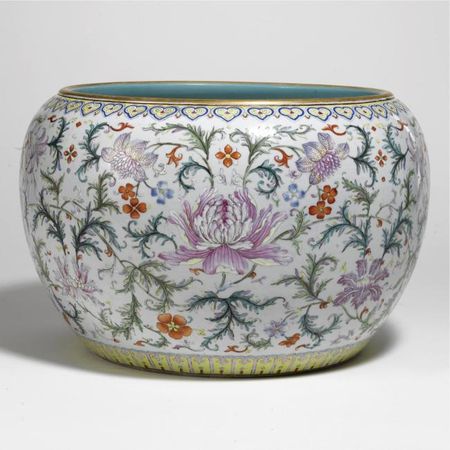A fine and large 'famille-rose' fish bowl. Qing dynasty, Qianlong period
A fine and large 'famille-rose' fish bowl. Qing dynasty, Qianlong period
the body of slightly compressed globular form rising from a recessed base to a broad lipped rim, finely enamelled around the exterior with large lotus flower heads amidst leafy composite floral strapwork, all between a lotus-lappet band at the base and a ruyi collar at the gilt rim, the interior and base turquoise. 40cm., 15 3/4 in. Est. 50,000—70,000 GBP. Lot Sold 199,250 GBP
PROVENANCE: Private Collection, England.
NOTE: Large fishbowls painted in this exceptional manner, that incorporates Western techniques with traditional Chinese decorative patterns, are extremely rare and no other similar example appears to be recorded. It is a fine example of a beautifully executed piece that is a synthesis of East and West. The vessel is painted in the yangcai (Western colours) enamels which, according to ceramics expert Liao Pao Show of the National Palace Museum, Taipei, owes its existence to the aesthetic taste of the Qianlong emperor and to the achievements of Tang Ying, Superintendent at the Imperial Kilns at Jingdezhen. In 'On Yang-ts'ai Porcelains of the Ch'ien-lung Reign' from the National Palace Museum exhibition catalogue, Stunning Decorative Porcelains from the Ch'ien-lung Reign, Taipei, 2008, Liao notes that the emperor was enamoured with his yangcai pieces and considered them to be representative of the technical innovation of his reign (see pp. 32-40).
The decorative technique employed on this vessel is first explained by Tang Ying in his work, A Brief Account of Ceramics, where he also notes that yangcai wares should be classified as wares using falang glazes with Western painting styles (ibid., p. 33). The rendering of the flowers, as seen on this piece, is painted with Western shading techniques that give the composition a three-dimensional aspect. White pigment is used on the leaves and flower petals to emphasize light and shadow and the overall pattern is influenced by Western-style floral compositions often seen on 17th century Limoges wares. For example, see a two-handled saucer from the collection of the Musee du Louvre, Paris, included in the exhibition From Beijing to Versailles, Hong Kong Museum of Art, Hong Kong, 1997, cat. no. 123. Compare also a Chinese ornament richly decorated with flowers, including large blooming flower heads with finely dotted petals, similar to that seen on this jardinière, published in Michel Beurdeley, Peintres Jesuites en Chine au XVIIIe Siecle, Paris, 1997, p. 200.
For further examples of pieces decorated with yangcai enamels, see a pair of large vases painted with Western-style flowers, from the collection of the National Palace Museum, Taipei, included in the museum's exhibition op.cit., cat. no. 33; and a square-form vase decorated with a flower scroll motif on a yellow-ground, ibid., cat. no. 34.
The shape of the present fishbowl is also unusual although the type is known from larger monochrome vessels of the Yongzheng period; for example see a light greenish-blue glazed vessel, from the Qing Court collection and still in Beijing, illustrated in The Complete Collection of Treasures of the Palace Museum. Monochrome Porcelain, Hong Kong, 1999, pl. 135.
Sotheby's. Fine Chinese Ceramics & Works of Art. 13 May 09. London www.sothebys.com

/https%3A%2F%2Fprofilepics.canalblog.com%2Fprofilepics%2F1%2F0%2F100183.jpg)
/https%3A%2F%2Fstorage.canalblog.com%2F03%2F02%2F119589%2F96711876_o.jpg)
/https%3A%2F%2Fstorage.canalblog.com%2F11%2F31%2F119589%2F94773502_o.jpg)
/https%3A%2F%2Fstorage.canalblog.com%2F20%2F83%2F119589%2F94772815_o.jpg)
/https%3A%2F%2Fstorage.canalblog.com%2F26%2F72%2F119589%2F75604929_o.jpg)
/https%3A%2F%2Fstorage.canalblog.com%2F59%2F60%2F119589%2F26458628_o.jpg)



/http%3A%2F%2Fstorage.canalblog.com%2F91%2F48%2F119589%2F128923043_o.jpg)
/http%3A%2F%2Fstorage.canalblog.com%2F84%2F09%2F119589%2F128922928_o.jpg)
/http%3A%2F%2Fstorage.canalblog.com%2F74%2F57%2F119589%2F128709421_o.jpg)
/http%3A%2F%2Fstorage.canalblog.com%2F96%2F72%2F119589%2F128683141_o.jpg)